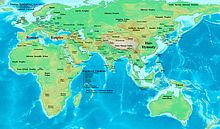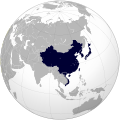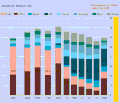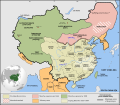
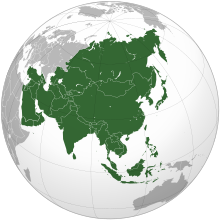 Asia (/ˈeɪʒə/ AY-zhə, UK also /ˈeɪʃə/ AY-shə) is the largest continent in the world by both land area and population. It covers an area of more than 44 million square kilometers, about 30% of Earth's total land area and 8% of Earth's total surface area. The continent, which has long been home to the majority of the human population, was the site of many of the first civilizations. Its 4.7 billion people constitute roughly 60% of the world's population. Asia shares the landmass of Eurasia with Europe, and of Afro-Eurasia with both Europe and Africa. In general terms, it is bounded on the east by the Pacific Ocean, on the south by the Indian Ocean, and on the north by the Arctic Ocean. The border of Asia with Europe is a historical and cultural construct, as there is no clear physical and geographical separation between them. It is somewhat arbitrary and has moved since its first conception in classical antiquity. The division of Eurasia into two continents reflects East–West cultural, linguistic, and ethnic differences, some of which vary on a spectrum rather than with a sharp dividing line. A commonly accepted division places Asia to the east of the Suez Canal separating it from Africa; and to the east of the Turkish Straits, the Ural Mountains and Ural River, and to the south of the Caucasus Mountains and the Caspian and Black seas, separating it from Europe. China and India traded places as the largest economies in the world from 1 to 1800 CE. China was a major economic power for much of recorded history, with the highest GDP per capita until 1500. The Silk Road became the main east–west trading route in the Asian hinterlands while the Straits of Malacca stood as a major sea route. Asia has exhibited economic dynamism as well as robust population growth during the 20th century, but overall population growth has since fallen. Asia was the birthplace of most of the world's mainstream religions including Hinduism, Zoroastrianism, Judaism, Jainism, Buddhism, Confucianism, Taoism, Christianity, Islam, Sikhism, as well as many other religions. (Full article...) Featured articleSino-Roman relations comprised the (primarily indirect) contacts and flows of trade goods, information, and occasional travelers between the Roman Empire and the Han dynasty, as well as between the later Eastern Roman Empire and various successive Chinese dynasties that followed. These empires inched progressively closer to each other in the course of the Roman expansion into ancient Western Asia and of the simultaneous Han military incursions into Central Asia. Mutual awareness remained low, and firm knowledge about each other was limited. Surviving records document only a few attempts at direct contact. Intermediate empires such as the Parthians and Kushans, seeking to maintain control over the lucrative silk trade, inhibited direct contact between the two ancient Eurasian powers. In 97 AD, the Chinese general Ban Chao tried to send his envoy Gan Ying to Rome, but Parthians dissuaded Gan from venturing beyond the Persian Gulf. Ancient Chinese historians recorded several alleged Roman emissaries to China. The first one on record, supposedly either from the Roman emperor Antoninus Pius or from his adopted son Marcus Aurelius, arrived in 166 AD. Others are recorded as arriving in 226 and 284 AD, followed by a long hiatus until the first recorded Byzantine embassy in 643 AD. The indirect exchange of goods on land along the Silk Road and sea routes involved (for example) Chinese silk, Roman glassware and high-quality cloth. Roman coins minted from the 1st century AD onwards have been found in China, as well as a coin of Maximian (Roman emperor from 286 to 305 AD) and medallions from the reigns of Antoninus Pius (r. 138–161 AD) and Marcus Aurelius (r. 161–180 AD) in Jiaozhi (in present-day Vietnam), the same region at which Chinese sources claim the Romans first landed. Roman glassware and silverware have been discovered at Chinese archaeological sites dated to the Han period (202 BC to 220 AD). Roman coins and glass beads have also been found in the Japanese archipelago. (Full article...)Selected Country Vietnam, officially the Socialist Republic of Vietnam (SRV), is a country at the eastern edge of mainland Southeast Asia, with an area of about 331,000 square kilometres (128,000 sq mi) and a population of over 100 million, making it the world's fifteenth-most populous country. One of the two Marxist-Leninist states in Southeast Asia, Vietnam shares land borders with China to the north, and Laos and Cambodia to the west. It shares maritime borders with Thailand through the Gulf of Thailand, and the Philippines, Indonesia, and Malaysia through the South China Sea. Its capital is Hanoi and its largest city is Ho Chi Minh City (commonly known as Saigon). Vietnam was inhabited by the Paleolithic age, with states established in the first millennium BC on the Red River Delta in modern-day northern Vietnam. The Han dynasty annexed Northern and Central Vietnam under Chinese rule from 111 BC, until the first dynasty emerged in 939. Successive monarchical dynasties absorbed Chinese influences through Confucianism and Buddhism, and expanded southward to the Mekong Delta, conquering Champa. During most of the 17th and 18th centuries, Vietnam was effectively divided into two domains of Đàng Trong and Đàng Ngoài. The Nguyễn—the last imperial dynasty—surrendered to France in 1883. In 1887, its territory was integrated into French Indochina as three separate regions. In the immediate aftermath of World War II, the nationalist coalition Viet Minh, led by the communist revolutionary Ho Chi Minh, launched the August Revolution and declared Vietnam's independence in 1945. (Full article...)Featured biography
Mukesh Dhirubhai Ambani (born 19 April 1957) is an Indian businessman and the chairman and managing director of Reliance Industries. With an estimated net worth of $113.7 billion as of March 2024, he is the richest person in Asia and 11th richest in the world. Sometimes characterized as a plutocrat, he has attracted both fame and notoriety for reports of market manipulation, political corruption, cronyism, and exploitation. (Full article...)
General imagesThe following are images from various Asia-related articles on Wikipedia. Featured picture Credit: Paul Rudd A Sikh pilgrim at the Harmandir Sahib, known informally as the "Golden Temple", located in the city of Amritsar, Punjab, India. The temple is the best-known of the Sikh gurdwaras and was completed in 1604. In the early nineteenth century, Maharaja Ranjit Singh covered the upper floors of the gurdwara with gold, giving it its distinctive appearance.
Did you know...
Updated: 6:33, 14 February 2024 In the news
Related portalsMajor Religions in Asia Middle East Central Asia and Surroundings Indian Subcontinent Southeast Asia East Asia Selected panorama
Credit: KennyOMG
The Indus River (locally called Sindhu) is one of the longest rivers in Asia. Originating in the Tibetan Plateau in the vicinity of Lake Manasarovar, the river runs a course through the Ladakh region of Jammu and Kashmir, India, towards the Gilgit-Baltistan region of Kashmir and the Hindukush ranges, and then flows in a southerly direction along the entire length of Pakistan to merge into the Arabian Sea near the port city of Karachi in Sindh. TopicsCategoriesAssociated WikimediaThe following Wikimedia Foundation sister projects provide more on this subject:
More portalsShortcuts to this page: Asia portal • P:ASIA Purge server cache |
